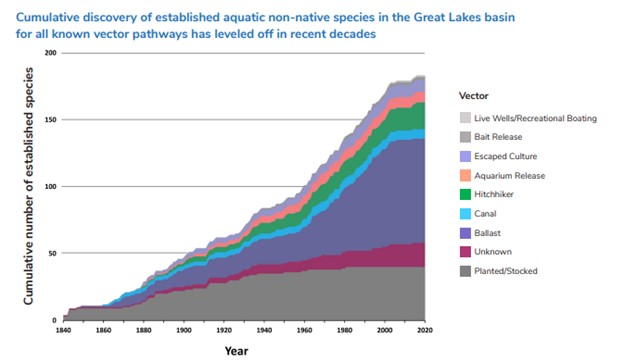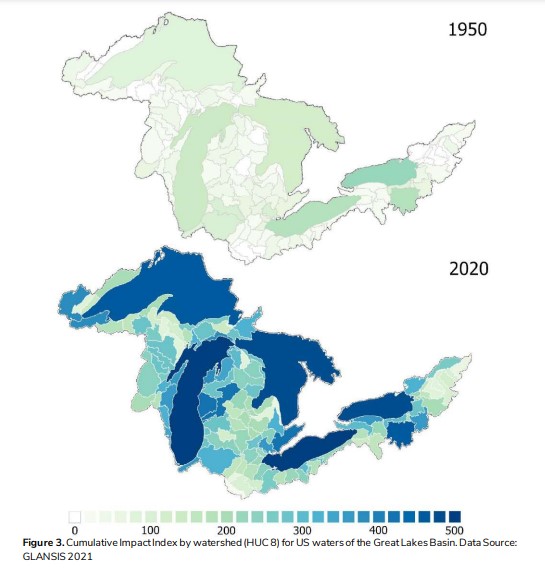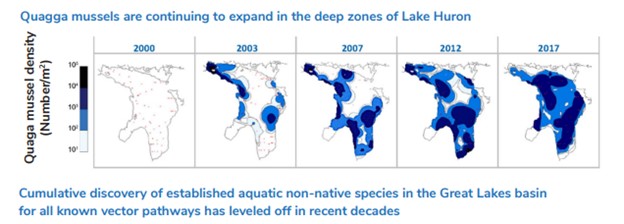State of the Great Lakes 2022 Reports: A look at prevention, control, and impact mitigation for aquatic invasive species in the Great Lakes
While prevention of overall new aquatic invasive species is rated as good, the impact of the continued spread of existing invasive species nets the lakes a "poor" rating.

The 2022 State of the Great Lakes (SOGL) Highlights and Technical Reports have recently been released, providing an overview of the status and trends in the Great Lakes ecosystems which are managed jointly by the U.S. and Canada under the Great Lakes Water Quality Agreement. More than 180 researchers on both sides of the border contributed to these reports, which represent ongoing collaboration between the U.S. and Canadian governments focusing on Great Lakes water quality.
The 2012 Great Lakes Water Quality Agreement states “the Great Lakes should be free from the introduction and spread of aquatic invasive species and free from the spread of terrestrial invasive species that adversely impact the quality of the Waters of the Great Lakes.” The 2022 report assesses five sub-indicators to provide insight into invasive species management efforts in the Great Lakes.
The good news
Prevention, measured as the rate of establishment of new aquatic nonnative species in the Great Lakes, is assessed as “good.” Four new species (all microscopic zooplankton) have been introduced and become established in the Great Lakes in the last decade:
- Thermocyclops crassus (2014)
- Salmincola californiensis (2014)
- Diaphanosoma fluviatile (2015)
- Mesocyclops pehpeiensis (2016)
The rate of new invasions for the current decade is lower than the previous 2 decades, but also significantly lower than the average rate from 1837-1949. No new species associated with ballast water have been introduced since 2006.

The bad news
Due to continued spread of recently established species between the lakes, the individual lake assessments for rate of new (to the individual lake) aquatic invasive species establishment is assessed as “fair'' for Lakes Michigan, Erie and Ontario, and “poor” for Lakes Superior and Huron. Species spreading to new lakes in the last decade include:
- fishes (bigmouth buffalo and tubenose goby)
- plants (flowering rush, brittle waternymph, marsh thistle, marsh lupine, European frogbit, and reed mannagrass)
- mollusks (Asian clam and New Zealand mudsnail)
- a small shrimp (bloody red shrimp)
- micro-organisms (Nitokra hibernica, Schizopera borutskyi, Neoergasilus japonicus, Heteropsyllus nunni, and Diaphanosoma fluviatile)
Combining the continued spread across the landscape (sub-watershed scale) with the impact of each of the individual invasive species (those documented to cause environmental or socio-economic harm), all of the Great Lakes are assessed as “poor” for the impact of aquatic invasive species.

Ongoing challenges
The final two sub-indicators address the status for a set of species with significant impacts and consequent management investments: sea lamprey and dreissenid mussels. These species represent active control efforts focused on mitigation of impact. Each one has a mixed level of success across the Great Lakes, with individual lakes rated “poor” (sea lamprey in Lake Superior, dreissenid mussels in Lakes Michigan, Huron and Ontario), “fair” (sea lamprey in Lake Huron, dreissenid mussels in Lake Erie) and “good” (sea lamprey in Lakes Michigan, Erie and Ontario, dreissenid mussels in Lake Superior).

The reports are available to read and download online: SOGL 2022 Highlights and Technical Reports.
Michigan Sea Grant Extension educator and GLANSIS program manager Rochelle Sturtevant led development of the first 3 sub-indicators (Rate of New Aquatic Nonindigenous Species Establishment in the Great Lakes, Impacts of Aquatic Invasive Species, and Rate of New Aquatic Nonindigenous Species Establishment into Each Lake Basin), and served as lead author of the corresponding sections of the invasive species chapter of the technical report. All data used for the assessment is available to the public through GLANSIS.
Michigan Sea Grant helps to foster economic growth and protect Michigan’s coastal, Great Lakes resources through education, research and outreach. A collaborative effort of the University of Michigan and Michigan State University and its MSU Extension, Michigan Sea Grant is part of the NOAA-National Sea Grant network of 34 university-based programs.
This article was prepared by Michigan Sea Grant under award NA180AR4170102 from the National Oceanic and Atmospheric Administration, U.S. Department of Commerce through the Regents of the University of Michigan. The statements, findings, conclusions, and recommendations are those of the author(s) and do not necessarily reflect the views of the National Oceanic and Atmospheric Administration, the Department of Commerce, or the Regents of the University of Michigan.



 Print
Print Email
Email

